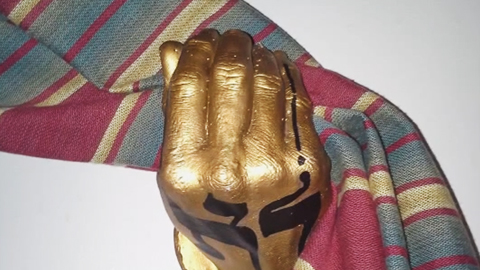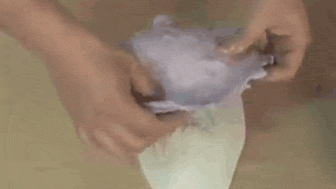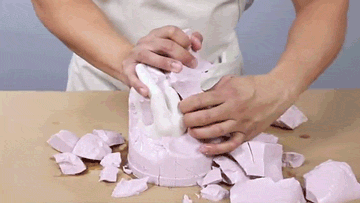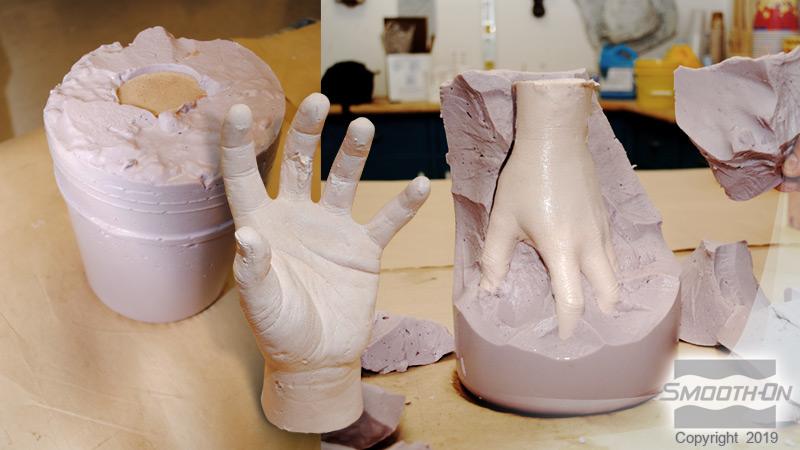Alja-Safe™
Safe to use Alja-Safe™ is the world’s first alginate molding powder that does not contain crystalline silica (a known carcinogen). Alja-Safe™ is perfect for making single-use molds of the face, hands and other body parts. It captures detail better than other alginates, giving you a more accurate reproduction of your original.
Certified Skin Safe - Material is skin safe and certified by an independent laboratory.
Features
Alja-Safe™ is easy to use and cures quickly. It reproduces fine detail and makes an excellent temporary mold – good for one or two reproductions of any body part. You can then cast plaster, platinum cure silicone rubber or Smooth-Cast™ 300Q ultra-fast urethane resin into the mold to make a reproduction.
For making re-usable molds of any body part, use Body Double™ silicone rubber.
IMPORTANT: This product has not been tested and should not be used for dental applications.
Starter Kit comes with:
- 0.85 lb. of Alja-Safe™ Molding Gel
- 2 lbs. Casting Plaster
- Quick Start Guide
Instructions
Preparation - Store and use Alja-Safe™ in a dry environment at room temperature. Alja-Safe™ powder may get warm in storage/shipping during the summer months which will cause the powder/water mixture to set too fast. To remedy, store Alja-Safe™ in a cool area (60°C - 70°F or 15°C - 31°C) for 24 hours before using. Alja-Safe™ has a limited shelf life and should be used as soon as possible. Do not allow moisture to come into contact with unused Alja-Safe™. Use only with adequate ventilation.
Practice: Make a mold of your thumb – make a mold of something small before going on to larger models. You’ll gain a lot of experience with a small test.
Applying A Release Agent – Alja-Safe™ will not stick to most surfaces. When making a mold of the head, a release preparation is recommended to prevent mechanical lock to the hair. CHOLESTEROL Brand Hair Conditioner (available at most pharmacies) can be applied to hair-covered areas prior to applying Alja-Safe™. It can be washed out of the hair easily after use.
Measuring – Alja-Safe™ is mixed 1 part water to 1 part powder by volume (1 cup + 1 cup, for example). You can vary the water level somewhat to change consistency of the mixture. Less water will make Alja-Safe™ thicker. More water will make the mixture thinner and easier to pour. Be careful…too much water will may result in the mixture not curing.
Water Quality – Water that has a high mineral content (calcium, phosphate, etc.) may cause any alginate to become “lumpy” or not set properly. A small-scale test is recommended prior to mixing large amounts. If water quality is in question, use distilled water heated to the correct temperature using a stove top or microwave oven if needed. Check water temperature using a thermometer.
Temperature Of The Water - At 80° F / 27° C, Alja-Safe™ will have a working time of 5 minutes and a demold time of 8 minutes. Warmer water will cause the material to cure faster (less working time). Colder water will give a longer working time and slower demold time. For best results, sift Alja-Safe™ powder into water and mix as directed.
Mixing – Alja-Safe™ can be hand mixed, but best results will be obtained using a power drill with a mixer attachment. Attach a Jiffy Mixer or Turbine Mixer to a power drill and mix for one minute (depending on volume) to a gel-like consistency – smooth without any powder lumps. Jiffy mixers are available at many hardware stores. Turbine Mixers will yield the best mix and are available from Smooth-On or your Smooth-On distributor.
Alja-Safe™ can be poured around an object or applied to vertical surfaces.
Pouring Around An Object - Once mixed, Alja-Safe™ can be poured around the hand, foot, fingers or other model in a fixed position inside a container. Suspend the model just above the bottom of the container and have at least ½" (1.27 cm) space between the model and the side walls of the container.
For Best Results: Apply a thin coating of Alja-Safe™ to the surface of the model by smoothing a small amount of material on by hand. Pour Alja-Safe™ into the container at the lowest point and let the material rise around the model. Make sure your model has a good clearance distance from the bottom and sides of the container. Keep your model still until the Alja-Safe™ sets up. You will know the Alja-Safe™ has set when it is firm and no longer gel-like.
For Vertical Application – You may want to experiment with the amount of water added to Alja-Safe™ to find a thicker consistency that is right for vertical surface application. For example, some customers mix 1 part water to 1.5 parts Alja-Safe™. Work Alja-Safe™ into model detail with your hands and let cure.
Applying A Support Shell - Once the alginate cures, a support shell will be necessary to support the alginate mold. Gypsona bandages are ideal for this purpose, and are available from Smooth-On or your Smooth-On distributor.
Casting Into The Mold - All alginate molds will deteriorate quickly. It is recommended that you cast into the mold within 4 hours following demold. Materials commonly cast into alginates include plaster, wax, clay and very fast urethane resins (such as Smooth-Cast 300Q). For Soft "Skin-Like" Castings – You can cast Dragon Skin 10 FAST soft silicone rubber into Alja-Safe™ molds to make realistic hands, limbs, etc.
Related Categories: Lifecasting Materials, Skin Safe FX Materials
Related Series: Alja-Safe™ Series – Skin Safe Crystalline-Silica Free Alginate
How-To Articles
![]()
How To Make a Fake Bloody Hand Prop Using Alja-Safe™ and Dragon Skin™ 10NV
We show how to make a realistic rubber hand with fake bloody accents.

How To Make Fake Zombie Fingers Using Alja-Safe™ and Ecoflex™ 00-35
Milo creates silicone zombie fingers with breakable bones for Halloween

How To Create a Resin Casting in an Alja-Safe™ Mold
This tutorial will show how to pour urethane resin into an alginate mold

Lifecasting Tutorial - How To Make Hand Curtain Holders
In this craft how-to, Smooth-On Fan Leo V. shows how to lifecast hands using alginate.

Martha Stewart Making a Hand Mold Using Alja-Safe®
Martha demonstrates how to create a personalized lifecast hand craft

Alja-Safe™ Hand Castings Go Wild!
Let your imagination run wild and create unexpected images with basic hand shapes.

How To Make a Face Casting with Alja-Safe® Crystalline Silica-Free Alginate
Alja-Safe® Crystalline Silica-Free Alginate is suitable for making temporary molds of the face, hands and other body parts.

Alja-Safe™ Alginate Quick Start Guide
Follow this simple step-by-step lifecasting guide, and you will have a perfect lifecasting which will 'freeze time'.

How To Use Alja-Safe™ Alginate to Cast Silicone Body Parts
Not only is Alja-Safe® safe and easy to, you can also cast platinum silicone rubbers directly into finished molds.

How To Create Lightweight Theatrical Costume Armor
Andreas Moravec demonstrates a technique for creating theatrical armor using Rebound™ 25 silicone and Smooth Cast® resins




